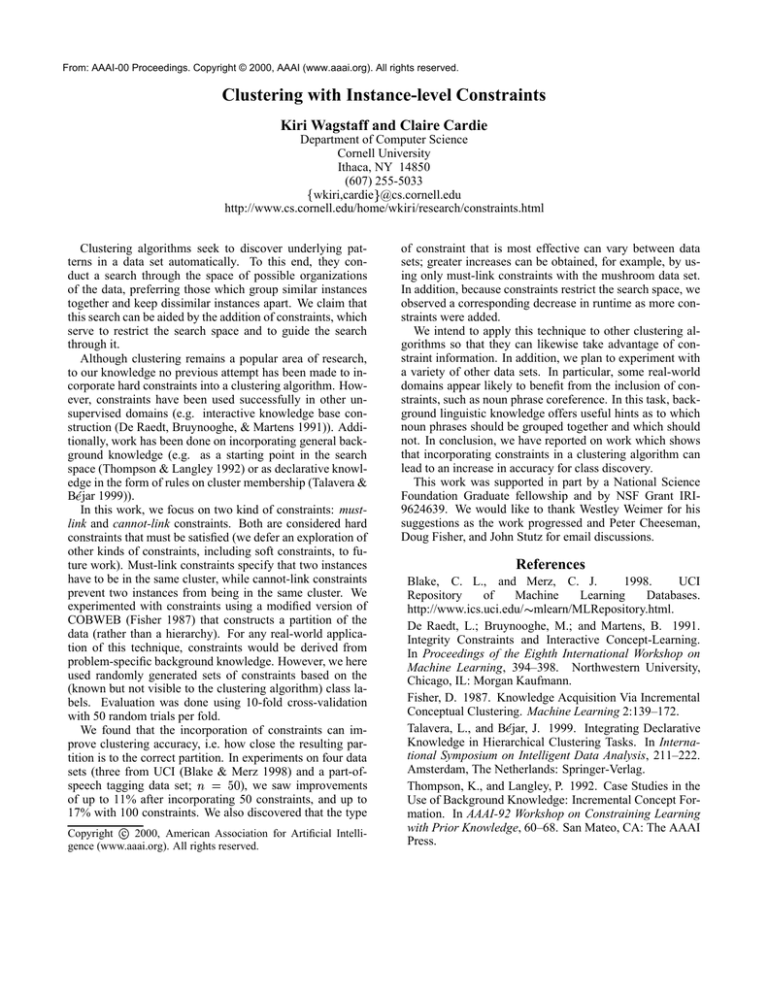
From: AAAI-00 Proceedings. Copyright © 2000, AAAI (www.aaai.org). All rights reserved.
Clustering with Instance-level Constraints
Kiri Wagstaff and Claire Cardie
Department of Computer Science
Cornell University
Ithaca, NY 14850
(607) 255-5033
wkiri,cardie @cs.cornell.edu
http://www.cs.cornell.edu/home/wkiri/research/constraints.html
Clustering algorithms seek to discover underlying patterns in a data set automatically. To this end, they conduct a search through the space of possible organizations
of the data, preferring those which group similar instances
together and keep dissimilar instances apart. We claim that
this search can be aided by the addition of constraints, which
serve to restrict the search space and to guide the search
through it.
Although clustering remains a popular area of research,
to our knowledge no previous attempt has been made to incorporate hard constraints into a clustering algorithm. However, constraints have been used successfully in other unsupervised domains (e.g. interactive knowledge base construction (De Raedt, Bruynooghe, & Martens 1991)). Additionally, work has been done on incorporating general background knowledge (e.g. as a starting point in the search
space (Thompson & Langley 1992) or as declarative knowledge in the form of rules on cluster membership (Talavera &
B jar 1999)).
In this work, we focus on two kind of constraints: mustlink and cannot-link constraints. Both are considered hard
constraints that must be satisfied (we defer an exploration of
other kinds of constraints, including soft constraints, to future work). Must-link constraints specify that two instances
have to be in the same cluster, while cannot-link constraints
prevent two instances from being in the same cluster. We
experimented with constraints using a modified version of
COBWEB (Fisher 1987) that constructs a partition of the
data (rather than a hierarchy). For any real-world application of this technique, constraints would be derived from
problem-specific background knowledge. However, we here
used randomly generated sets of constraints based on the
(known but not visible to the clustering algorithm) class labels. Evaluation was done using 10-fold cross-validation
with 50 random trials per fold.
We found that the incorporation of constraints can improve clustering accuracy, i.e. how close the resulting partition is to the correct partition. In experiments on four data
sets (three from UCI (Blake & Merz 1998) and a part-of), we saw improvements
speech tagging data set;
of up to 11% after incorporating 50 constraints, and up to
17% with 100 constraints. We also discovered that the type
Copyright c 2000, American Association for Artificial Intelligence (www.aaai.org). All rights reserved.
of constraint that is most effective can vary between data
sets; greater increases can be obtained, for example, by using only must-link constraints with the mushroom data set.
In addition, because constraints restrict the search space, we
observed a corresponding decrease in runtime as more constraints were added.
We intend to apply this technique to other clustering algorithms so that they can likewise take advantage of constraint information. In addition, we plan to experiment with
a variety of other data sets. In particular, some real-world
domains appear likely to benefit from the inclusion of constraints, such as noun phrase coreference. In this task, background linguistic knowledge offers useful hints as to which
noun phrases should be grouped together and which should
not. In conclusion, we have reported on work which shows
that incorporating constraints in a clustering algorithm can
lead to an increase in accuracy for class discovery.
This work was supported in part by a National Science
Foundation Graduate fellowship and by NSF Grant IRI9624639. We would like to thank Westley Weimer for his
suggestions as the work progressed and Peter Cheeseman,
Doug Fisher, and John Stutz for email discussions.
References
Blake, C. L., and Merz, C. J.
1998.
UCI
Repository
of
Machine
Learning
Databases.
http://www.ics.uci.edu/ mlearn/MLRepository.html.
De Raedt, L.; Bruynooghe, M.; and Martens, B. 1991.
Integrity Constraints and Interactive Concept-Learning.
In Proceedings of the Eighth International Workshop on
Machine Learning, 394–398. Northwestern University,
Chicago, IL: Morgan Kaufmann.
Fisher, D. 1987. Knowledge Acquisition Via Incremental
Conceptual Clustering. Machine Learning 2:139–172.
Talavera, L., and B jar, J. 1999. Integrating Declarative
Knowledge in Hierarchical Clustering Tasks. In International Symposium on Intelligent Data Analysis, 211–222.
Amsterdam, The Netherlands: Springer-Verlag.
Thompson, K., and Langley, P. 1992. Case Studies in the
Use of Background Knowledge: Incremental Concept Formation. In AAAI-92 Workshop on Constraining Learning
with Prior Knowledge, 60–68. San Mateo, CA: The AAAI
Press.





